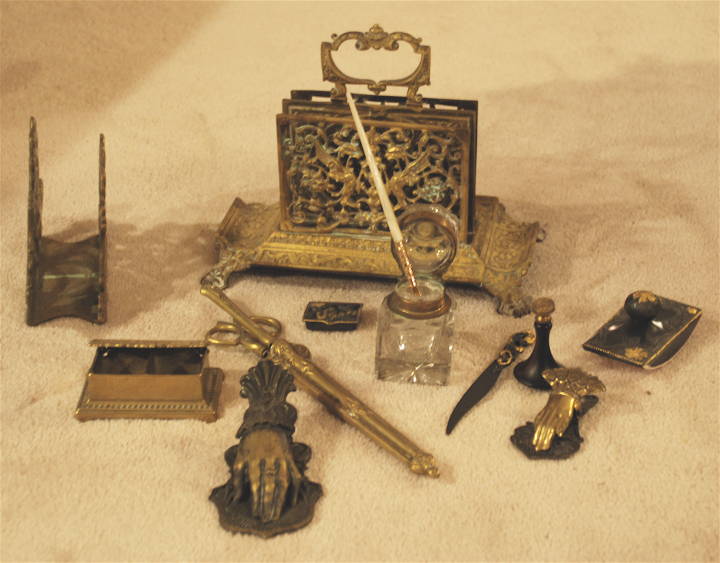The Penny Post of 1840 arose during the rapidly growing age of production and consumption in Britain, the undisputed leader of the Industrial Revolution. Uniform Penny Postage led to an increase in the number of post offices, daily mail deliveries, and letters of business, education, and personal correspondence; in turn, the Penny Post stimulated a new field of industry — postal products. Savvy manufacturers created a range of high-end and mass-produced postal products to make writing a convenience and an aesthetic pleasure.
Left: Victorian postal products. Middle: Four decorative paper or letter clips. Right: A Paper clip attached to a letter [Click on thumbnails for larger images.]
Postal products provide information about aesthetics, gender, social class, and Empire. Envelope production soared since there was a uniform rate of postage, and a letter mailed in an envelope could travel anywhere in the UK for only a penny, as long as the weight did not exceed ½ ounce. An envelope-folding machine which could fold and gum 45 envelopes a minute (designed by postal reformer Rowland Hill’s brother Edwin Hill and Warren De la Rue) went on display at the Great Exhibition and earned the praise of Queen Victoria (Golden 132; Briggs 64). Illustrated envelopes became a craze that peaked in 1841 and then resurged in the late 1840s and 1850s. A ready vehicle for commemoration as well as commercial advertising and propaganda, pictorial envelopes celebrated important occasions, such as the marriage of Victoria and Albert (1840) and the Great Exhibition of 1851, and promoted numerous causes, including peace, brotherhood, temperance, and affordable transatlantic postage. Other envelopes show a comical view of Victorian daily activities, including horse racing, shooting, courting, and dancing. Leading Birmingham designer and manufacturer Jennens & Bettridge, known as “Makers to the Queen” (Harris 145), created papier maché desk sets and writing desks in two grades to reach upper-class and middle-class consumers. Skilled handwork for the wealthy female consumer use specialty woods or high grade papier maché, quality veneers, and rich embellishments. These kinds of collectible commodities tell us what the Victorians treasured and commemorated and carry opinions on aesthetics, current events, humor, and gender preferences.
Related Material
- Art Nouveau inkstand in gilt bronze by Réné Foy (1899)
- Letter Rack designed by Charles Robert Ashbee
- Tudric Inkwell designed by Archibald Knox (c. 1900)
- Art Nouveau Inkwell attributed to Archibald Knox
References
Briggs, Asa. Victorian Things. Chicago: University of Chicago Press, 1989.
Golden, Catherine J. Posting It: The Victorian Revolution in Letter Writing. Gainesville: University Press of Florida, 2009.
Harris, David. Portable Writing Desks. Buckinghamshire, UK: Shire Publications Ltd., 2001.
Last modified 7 June 2010


